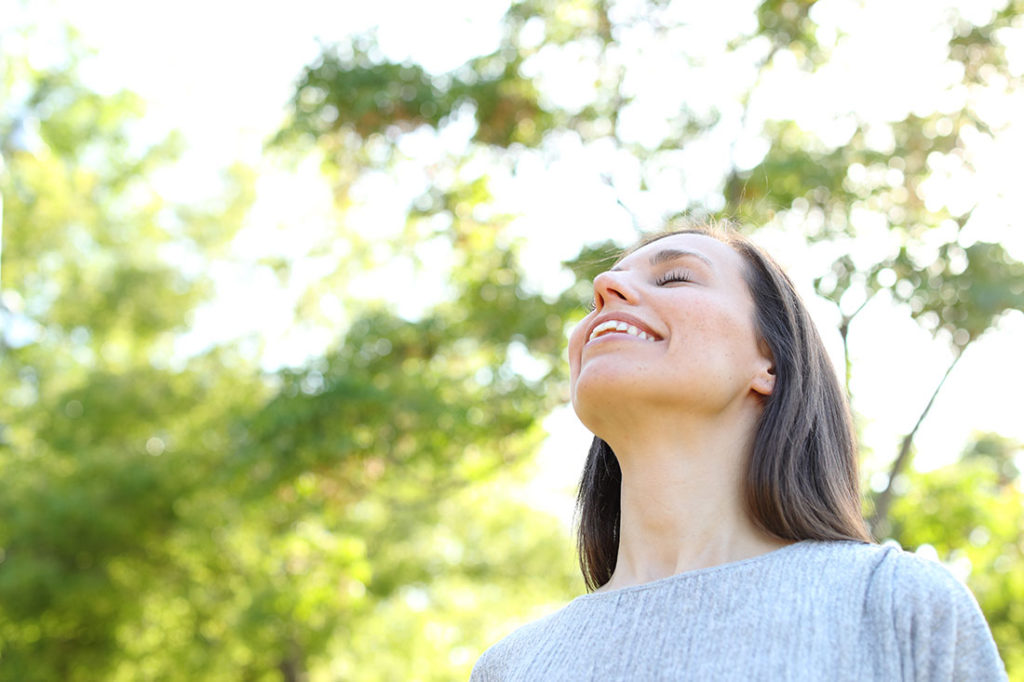“Look, a monkey!” I yell as I eagerly peer into the greenery on my left.
“Look over here,” my husband then says. “There’s a trail of leaf-cutter ants!”
We’re at Mistico Arenal Hanging Bridges Park in Costa Rica, a nature preserve filled with wildlife, lush greenery and suspended bridges that hang hundreds of feet above the ground.
Before arriving, I felt the familiar onslaught of anxiety—shallow breathing, tight chest, tense shoulders. I launched my freelance career just a few weeks prior, and was worried about building my client base.
After two hours strolling through the forest trails, my worries slowly faded away. I could catch my breath again and my shoulders loosened up. The client problem no longer loomed large in my mind.
For years, I’ve known that walking in nature helps me manage my anxiety. What I didn’t know was that there was a word to describe using the outdoors to quiet one’s mind: ecotherapy.
Ecotherapy is a broad term that can apply to many different activities, says Joe Hinds, a psychotherapist based in the U.K. and co-author of the book Ecotherapy: Theory, Research & Practice. Ecotherapy can mean spending time in nature while undergoing a therapy session with a trained therapist, he says. It also encompasses countless outdoor activities—gardening, white-water rafting, rock climbing, strolling through nature, horseback riding, tending farmland and petting animals are all forms of ecotherapy.
Although ecotherapy is something humans have naturally engaged in for years, some doctors have begun writing “park prescriptions” in which they specifically advise their patients with anxiety or depression to walk through nature.
“In my mind, it’s a natural tendency for us as human beings to want to have contact with nature in some form,” Hinds says. “It’s a universal thing. That can be a simple thing like having a goldfish in your front garden all the way through to a wilderness experience.”
A Natural Fit
Ample studies have been done in order to better understand what’s at play on a physiological level when we engage in ecotherapy. One research study found those who walked in nature versus a more urban setting for 90 minutes experienced lower blood pressure, lower levels of the stress hormone cortisol, a decreased heart rate and lower levels of rumination, or excessive worrying. Hinds says additional research has also shown that the denser one’s urban environment, the more negative of an effect it can have on a person with mental health issues.
Another study found that time outdoors can significantly reduce the symptoms of ADHD in children. Plus, walking in nature can also boost self-esteem in people with depression, according to a 2007 study from the University of Essex.
One main theory for why ecotherapy works, Hinds says, is the biophilia hypothesis, “which says that because of our long and enduring evolutionary contact with nature, we behave optimally within natural environments,” he says. “It’s only more recently that, in evolutionary terms, we’ve moved into built environments.”
There’s also something called the attention restoration theory (ART), Hinds says, which suggests that we become softly fascinated with the aesthetic beauty of nature and that’s what draws us in. This theory resonated most with me—when I go hiking, I often spend time marveling at the wildflowers, rock formations and scenery, and this fascination is what calms my nerves.
“That same theory also says that our modern-day living is so intense—we’re bombarded with multisensory stimuli all the time—and when we get out into nature, all of those things shut down and we begin to recharge cognitively,” Hinds says.
A Long and Enduring History
Although the term ecotherapy is new to many, it’s something people have practiced for centuries. Think of philosophers like Walt Whitman and Henry David Thoreau, who strolled through nature while pondering their thoughts. Or Sigmund Freud, who often took patients to beaches and forests, says Hans Watson, a psychotherapist based in Great Falls, Montana, who uses ecotherapy in his practice.
Anyone and everyone can benefit from ecotherapy, though there are particular mental health conditions it’s often used to treat.
“Studies show that experiences in natural settings—like a walk outside—can have a tremendous effect on individuals suffering from stress, anxiety and depression, as well as other mood disorders,” says Jennifer Owens, a psychotherapist based in Louisville, Kentucky, who practices ecotherapy.
One example of ecotherapy in action would be someone with debilitating anxiety walking through nature in order to practice mindfulness and relaxation, Watson says.
Another example is equine-assisted therapy, which involves petting, riding and engaging with horses. This type of ecotherapy has been used with combat veterans who have recently returned to the U.S. and suffer from post-traumatic stress disorder (PTSD).
“A combat veteran with PTSD continually fears being attacked by an unseen enemy,” Watson says. Horseback riding is a time when veterans can be mindful of this fear while also recognizing that the horse is not fearful. This calms down their amygdala, the fear center of the brain, he says. “They can use that experience to start reality-checking whether they are in actual danger or just fear being in danger.”
Using Ecotherapy in Your Own Life
One form of ecotherapy involves participating in a guided therapy session with a therapist in nature. If you’re inclined to try this type of ecotherapy, Hinds says it’s important to make sure you’re working with a trained professional. People are often exposed and vulnerable during a therapeutic session, which is only magnified in a wide-open environment.
If you’re more interested in engaging in ecotherapy on your own, it’s important to remember that there is no one-size-fits all approach. One person might feel enhanced well-being after three hours of gardening, while someone else might benefit more from a white-water rafting trip. “You have to find your own way,” Hinds says.
Interested in putting ecotherapy into practice in your own life? Owens offers the following tips to get started:
- Take a mindful walk outdoors. Walk very slowly and focus on your breathing. Notice your feet making contact with the earth.
- Go on a sensory walk where you focus on just one sense. For example, focus on your sense of hearing—notice all the sound patterns and forms of communication around you. On your next walk, focus on touch and the textures of the natural world.
- Walk barefoot. Or, sit or stand barefoot outside for at least 10 minutes.
If you can’t get outside, consider the following suggestions from Owen:
- Buy a few houseplants. Looking at them can decrease symptoms of depression and anxiety.
- Marvel at nature. When you’re stuck in traffic or at a stoplight, take time to gaze at the trees around you instead of looking at your phone.
- Channel the sun. Increase your sun intake by sitting close to windows where the light shines in. Or, sit outside on your porch or deck.
Photo by Antonio Guillem/Shutterstock.com










